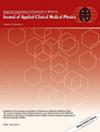Automated radiotherapy planning for volumetric modulated arc therapy in lung cancer
Abstract
Background
Volumetric-modulated arc therapy (VMAT) treatment planning balances the need for adequate coverage of the planning target volume (PTV) and the sparing of organs-at-risk (OARs). However, this time-consuming iterative process is influenced by the planner's experience, personal preferences, and the time devoted to create the plan. This often leads to a considerable variability in plan quality.
Purpose
For lung tumors, where PTV size and the relative location between OARs and PTV vary widely, these challenges are particularly pronounced. This work aims to develop an automated treatment planning solution for lung tumors, standardizing the process and ensuring consistent, high-quality plans while significantly reducing the planner's active workload and time investment
Methods
An automated treatment planning software, named Uniklinikum Erlangen-Automated Treatment Planning (UKER-ATP), developed within the RayStation (RaySearch, Stockholm, Sweden, Version 12A) treatment planning system using its Python interface, was employed to automate the entire planning process. This software combines both scripted and knowledge-based methods; for the latter, overlap-z-histogram (OZH) and overlap volume histogram (OVH) were used to predict dose volume histograms (DVHs). This study included 15 clinical lung cancer patients with manually created VMAT treatment plans as part of their therapy. For each patient, an automated plan (AP) was generated and compared with the manual plan (MP) created by physicists in our institute. Dosimetric parameters and plan quality indices were evaluated. Furthermore, four board-certified physicians conducted a direct comparison of the plans to assess quality.
Results
The APs achieved comparable coverage of the PTV while demonstrating improved dose conformity and uniformity compared with the MPs. Mean dose and of the total lung were significantly lower in the APs compared with those in the MPs ( < 0.01, = 0.01 respectively); the mean dose of the heart was also significantly reduced in the APs ( < 0.05). Furthermore, APs presented less variability in DVH metrics. 57% of the AP plans were rated by physicians as superior to their manually created counterparts, and 78% were rated as either superior or equivalent. In most cases, MPs selected as superior were created by highly experienced planners, whereas APs were consistently preferred when MPs had been created by less experienced planners. This trend is supported by a significant negative between planner experience and AP superiority (Spearman's = –0.541, = 0.037), suggesting that APs tend to outperform MPs when planner experience is limited.
Conclusion
Our automated VMAT plan creation software, especially designed for lung tumors, effectively achieves target coverage while minimizing doses to OARs. Despite the complexities associated with lung tumors, such as variable PTV sizes and OAR locations, the software demonstrated robust performance.


 求助内容:
求助内容: 应助结果提醒方式:
应助结果提醒方式:


